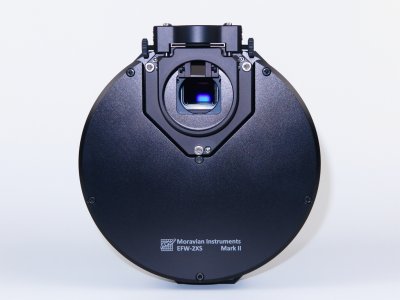|
The C2-46000 also employs the 4/3 standard sensor and the imaging
area is very similar to the famous G2-8300
(19.3 mm × 13.1 mm vs. 18.1 mm × 13.7 mm), only the CMOS based C2-46000 offers much
greater number (46 M vs. 8 M) of much smaller pixels
(2.315 μm vs. 5.4 μm). But the C2-46000 can be
binned 2 × 2 to get the comparable number
of similarly sized pixels (approx. 12 M).
Thanks to the great download speed of the CMOS sensor and the C2-46000
ability to 2 × 2 bin pixels in camera
hardware, the download speed is still much faster compared to its CCD
predecessor (0.2 s vs.
5 s). The binning brings one more
advantage — while the C2-46000 operates with
12-bit digitization at full resolution, the 2 × 2 binned images offer 14-bit dynamic range.

The C2-46000 shares all the features of the C2 camera series, like
the efficient and regulated sensor cooling, mechanical shutter for
automatic dark and bias frames, compatibility with a wide range of
internal and external filter wheels, OAG adapters, Canon EOS and Nikon
lens bayonet adapters etc. So, the C2-46000 easily slips into an
existing imaging setup like any other C2 camera.
The image above is the first light image, taken with the C2-46000
camera prototype on 400 mm, f/4 Newtonian
telescope. Even the full-size image, available on click on the image
thumbnail, is actually scaled down from full resolution. So, we
cropped a 1024 × 768 sub-frame from the
original image and included it below to demonstrate the excellent
resolution of the C2-46000's 46-megapixel sensor.
The C2-46000 is also an excellent camera for deep sky imaging. We
haven't had enough time to get a full color image yet, but this white
light image of NGC4565 gives an indication of its capabilities.
Images above were captured by Martin Myslivec.
To get more details about the new C2-46000, visit the C2
camera product page.
| 